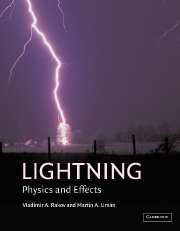Book contents
- Frontmatter
- Contents
- Preface
- 1 Introduction
- 2 Incidence of lightning
- 3 Electrical structure of lightning-producing clouds
- 4 Downward negative lightning discharges to ground
- 5 Positive and bipolar lightning discharges to ground
- 6 Upward lightning initiated by ground-based objects
- 7 Artificial initiation (triggering) of lightning by ground-based activity
- 8 Winter lightning in Japan
- 9 Cloud discharges
- 10 Lightning and airborne vehicles
- 11 Thunder
- 12 Modeling of lightning processes
- 13 The distant lightning electromagnetic environment: atmospherics, Schumann resonances, and whistlers
- 14 Lightning effects in the middle and upper atmosphere
- 15 Lightning effects on the chemistry of the atmosphere
- 16 Extraterrestrial lightning
- 17 Lightning locating systems
- 18 Deleterious effects of lightning and protective techniques
- 19 Lightning hazards to humans and animals
- 20 Ball lightning, bead lightning, and other unusual discharges
- Appendix: Books on lightning and related subjects
- Index
10 - Lightning and airborne vehicles
Published online by Cambridge University Press: 05 June 2013
- Frontmatter
- Contents
- Preface
- 1 Introduction
- 2 Incidence of lightning
- 3 Electrical structure of lightning-producing clouds
- 4 Downward negative lightning discharges to ground
- 5 Positive and bipolar lightning discharges to ground
- 6 Upward lightning initiated by ground-based objects
- 7 Artificial initiation (triggering) of lightning by ground-based activity
- 8 Winter lightning in Japan
- 9 Cloud discharges
- 10 Lightning and airborne vehicles
- 11 Thunder
- 12 Modeling of lightning processes
- 13 The distant lightning electromagnetic environment: atmospherics, Schumann resonances, and whistlers
- 14 Lightning effects in the middle and upper atmosphere
- 15 Lightning effects on the chemistry of the atmosphere
- 16 Extraterrestrial lightning
- 17 Lightning locating systems
- 18 Deleterious effects of lightning and protective techniques
- 19 Lightning hazards to humans and animals
- 20 Ball lightning, bead lightning, and other unusual discharges
- Appendix: Books on lightning and related subjects
- Index
Summary
… when a large conductor, such as an aircraft, intrudes into the cloud, the field intensification it creates is sufficient to artificially initiate or ‘trigger’ a lightning flash.
E.T. Pierce (1976)Introduction
Most lightning strikes to aircraft in flight are initiated by the aircraft, as opposed to the intercepted a discharge already in progress, although this was not convincingly demonstrated to be the case until the 1980s. Even in the case of the interception of a natural lightning flash, there is likely to be a significant discharge initiated from the aircraft in response to the naturally occurring channel. A video frame showing evidence of the initiation of lightning by an aircraft at relatively low altitude is found in Fig. 10.1. That the lightning shown in Fig. 10.1 was initiated at the aircraft is indicated by the different directions of channel branching above and below the aircraft. The apparently similar artificial initiation of lightning by an ungrounded wire trailing behind a small rocket, so-called “altitude triggering”, is discussed in subsection 7.2.1. Early arguments that aircraft could initiate lightning were based primarily on the many observed cases of lightning strikes to aircraft inside or near clouds that previously had not produced natural lightning (e.g., Harrison L.P. 1946; Harrison H.T. 1965; Fitzgerald 1967; Clifford and Kasemir 1982). The first direct evidence of the initiation of a lightning strike by an aircraft was provided by UHF radar echoes of lightning channel formation during strikes to the NASA F-106B research aircraft (subsection 10.3.2) showing that the initial leader channels originated at or very near (the radar resolution was 150 m) the F-106B and propagated away from it (Mazur et al. 1984a).
Information
- Type
- Chapter
- Information
- LightningPhysics and Effects, pp. 346 - 373Publisher: Cambridge University PressPrint publication year: 2003
Accessibility standard: Unknown
Why this information is here
This section outlines the accessibility features of this content - including support for screen readers, full keyboard navigation and high-contrast display options. This may not be relevant for you.Accessibility Information
- 4
- Cited by
